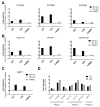Nevirapine Biotransformation Insights: An Integrated In Vitro Approach Unveils the Biocompetence and Glutathiolomic Profile of a Human Hepatocyte-Like Cell 3D Model
- PMID: 32503263
- PMCID: PMC7312429
- DOI: 10.3390/ijms21113998
Nevirapine Biotransformation Insights: An Integrated In Vitro Approach Unveils the Biocompetence and Glutathiolomic Profile of a Human Hepatocyte-Like Cell 3D Model
Abstract
The need for competent in vitro liver models for toxicological assessment persists. The differentiation of stem cells into hepatocyte-like cells (HLC) has been adopted due to its human origin and availability. Our aim was to study the usefulness of an in vitro 3D model of mesenchymal stem cell-derived HLCs. 3D spheroids (3D-HLC) or monolayer (2D-HLC) cultures of HLCs were treated with the hepatotoxic drug nevirapine (NVP) for 3 and 10 days followed by analyses of Phase I and II metabolites, biotransformation enzymes and drug transporters involved in NVP disposition. To ascertain the toxic effects of NVP and its major metabolites, the changes in the glutathione net flux were also investigated. Phase I enzymes were induced in both systems yielding all known correspondent NVP metabolites. However, 3D-HLCs showed higher biocompetence in producing Phase II NVP metabolites and upregulating Phase II enzymes and MRP7. Accordingly, NVP-exposure led to decreased glutathione availability and alterations in the intracellular dynamics disfavoring free reduced glutathione and glutathionylated protein pools. Overall, these results demonstrate the adequacy of the 3D-HLC model for studying the bioactivation/metabolism of NVP representing a further step to unveil toxicity mechanisms associated with glutathione net flux changes.
Keywords: 3D culture; glutathione; hepatocytes; metabolism; nevirapine; stem cells.
Conflict of interest statement
The authors declare no conflict of interest. The funders had no role in the design of the study; in the collection, analyses, or interpretation of data; in the writing of the manuscript, or in the decision to publish the results.
Figures







Similar articles
-
Hepatocyte spheroids as a competent in vitro system for drug biotransformation studies: nevirapine as a bioactivation case study.Arch Toxicol. 2017 Mar;91(3):1199-1211. doi: 10.1007/s00204-016-1792-x. Epub 2016 Jul 14. Arch Toxicol. 2017. PMID: 27417440
-
Self-assembled 3D spheroids and hollow-fibre bioreactors improve MSC-derived hepatocyte-like cell maturation in vitro.Arch Toxicol. 2017 Apr;91(4):1815-1832. doi: 10.1007/s00204-016-1838-0. Epub 2016 Sep 2. Arch Toxicol. 2017. PMID: 27590069
-
Enhanced Metabolizing Activity of Human ES Cell-Derived Hepatocytes Using a 3D Culture System with Repeated Exposures to Xenobiotics.Toxicol Sci. 2015 Sep;147(1):190-206. doi: 10.1093/toxsci/kfv121. Epub 2015 Jun 17. Toxicol Sci. 2015. PMID: 26089346
-
Fish hepatocyte spheroids - A powerful (though underexplored) alternative in vitro model to study hepatotoxicity.Comp Biochem Physiol C Toxicol Pharmacol. 2022 Dec;262:109470. doi: 10.1016/j.cbpc.2022.109470. Epub 2022 Sep 16. Comp Biochem Physiol C Toxicol Pharmacol. 2022. PMID: 36122680 Review.
-
Singularities of nevirapine metabolism: from sex-dependent differences to idiosyncratic toxicity.Drug Metab Rev. 2019 Feb;51(1):76-90. doi: 10.1080/03602532.2019.1577891. Epub 2019 Mar 29. Drug Metab Rev. 2019. PMID: 30712401 Review.
Cited by
-
The Redox-Active Manganese(III) Porphyrin, MnTnBuOE-2-PyP5+, Impairs the Migration and Invasion of Non-Small Cell Lung Cancer Cells, Either Alone or Combined with Cisplatin.Cancers (Basel). 2023 Jul 27;15(15):3814. doi: 10.3390/cancers15153814. Cancers (Basel). 2023. PMID: 37568630 Free PMC article.
-
MnTnHex-2-PyP5+ Displays Anticancer Properties and Enhances Cisplatin Effects in Non-Small Cell Lung Cancer Cells.Antioxidants (Basel). 2022 Nov 7;11(11):2198. doi: 10.3390/antiox11112198. Antioxidants (Basel). 2022. PMID: 36358570 Free PMC article.
-
Enantioselectivity of Pentedrone and Methylone on Metabolic Profiling in 2D and 3D Human Hepatocyte-like Cells.Pharmaceuticals (Basel). 2022 Mar 17;15(3):368. doi: 10.3390/ph15030368. Pharmaceuticals (Basel). 2022. PMID: 35337165 Free PMC article.
-
Improving human mesenchymal stem cell-derived hepatic cell energy metabolism by manipulating glucose homeostasis and glucocorticoid signaling.Front Endocrinol (Lausanne). 2023 Jan 13;13:1043543. doi: 10.3389/fendo.2022.1043543. eCollection 2022. Front Endocrinol (Lausanne). 2023. PMID: 36714559 Free PMC article.
-
Oxidative Stress in Drug-Induced Liver Injury (DILI): From Mechanisms to Biomarkers for Use in Clinical Practice.Antioxidants (Basel). 2021 Mar 5;10(3):390. doi: 10.3390/antiox10030390. Antioxidants (Basel). 2021. PMID: 33807700 Free PMC article. Review.
References
-
- Godoy P., Hewitt N.J., Albrecht U., Andersen M.E., Ansari N., Bhattacharya S., Bode J.G., Bolleyn J., Borner C., Böttger J., et al. Recent advances in 2D and 3D in vitro systems using primary hepatocytes, alternative hepatocyte sources and non-parenchymal liver cells and their use in investigating mechanisms of hepatotoxicity, cell signaling and ADME. Arch. Toxicol. 2013;87:1315–1530. doi: 10.1007/s00204-013-1078-5. - DOI - PMC - PubMed
-
- Zuang V., Dura A., Bofill D.A., Barroso J.F.V., Leite S.B., Belz S., Berggren E., Bernasconi C., Bopp S., Bouhfid M., et al. EURL ECVAM Status Report on the Development, Validation and Regulatory Acceptance of Alternative Methods and Approaches (2018) Publications Office of the EU; Luxembourg: 2019.
-
- Cipriano M., Correia J.C., Camões S.P., Oliveira N.G., Cruz P., Cruz H., Castro M., Ruas J.L., Santos J.M., Miranda J.P. The role of epigenetic modifiers in extended cultures of functional hepatocyte-like cells derived from human neonatal mesenchymal stem cells. Arch. Toxicol. 2017;91:2469–2489. doi: 10.1007/s00204-016-1901-x. - DOI - PubMed
-
- Cipriano M., Freyer N., Knöspel F., Oliveira N.G., Barcia R., Cruz P.E., Cruz H., Castro M., Santos J.M., Zeilinger K., et al. Self-assembled 3D spheroids and hollow-fibre bioreactors improve MSC-derived hepatocyte-like cell maturation in vitro. Arch. Toxicol. 2017;91:1815–1832. doi: 10.1007/s00204-016-1838-0. - DOI - PubMed
MeSH terms
Substances
Grants and funding
LinkOut - more resources
Full Text Sources

